

 |
 |
| Manufacturer/Model | TSO | Rated Capacity | Price USD* | Weight (lbs.)* | Area/Person** | Tubes/Depth*** |
| Air Cruisers | Yes | 4 | $6,900 | 38.8 | 3.7 | 2/18 |
| Air Cruisers | Yes | 13 | $9,800 | 71.8 | 3.4 | 2/24 |
| BFGoodrich | Yes | 4 | $6,811 | 41.2 | 3.6 | 2/18 |
| BFGoodrich | Yes | 12 | $9,512 | 69.4 | 3.6 | 2/18 |
| Hoover FR-6 | Yes | 6 | NA**** | 56.2 | 3.6 | 2/22 |
| Survival Products RAF1104-101 | No | 4 | $1,425 | 16.4 | 3.7 | 1/11 |
| Survival Products RAF1104-105 | Yes | 4 | $2,386 | 27.2 | 3.7 | 1/11 |
| Survival Products RAF1206-105 | Yes | 6 | $4,220 | 41 | 3.6 | 2/19 |
| Winslow Island Flyer GAST | No | 4 | $2,775 | 42 | 4.0 | 1/13 |
| Winslow Ultima FAAV | Yes | 4 | $6,270 | 54.4 | 3.8 | 2/20 |
| Winslow Ultima FAAV | Yes | 12 | $9,240 | 92 | 3.7 | 2/26 |
| Winslow Ultra-Light FAUL | Yes | 4 | $6,920 | 42 | 4.3 | 2/15 |
| Winslow Ultra-Light FAUL | Yes | 10 | $8,012 | 67.4 | 4.3 | 2/15 |
| Winslow Ultra-Light FAUL | Yes | 12 | $10,247 | 74.8 | 4.3 | 2/16.5 |
| * As tested including: valise, Part 135 SEP w/ ELT and PUR-06, except as noted in text (Prices as of 02/28/00) ** Square feet rounded to nearest tenth, per person based on rated capacity *** Number of buoyancy tubes / Total height of tubes **** Hoover declined to provide a price, saying only that rafts were available from $2,600 and up |
||||||
Let's first take a brief look at the rafts that were evaluated and then go into a detailed evaluation of the various areas of concern.
The Survival Products "4 to 6 Person" raft is very lightweight, (12 lbs. with no supplementary survival kit, 21 lbs. with the "Part 135" survival kit) and compact. This square shaped, single cell raft is constructed of traditional neoprene FAA approved material. The corners are constructed by bending the 11 inch tube and then covered the resulting corner with seam tape. No canopy is included with the standard raft, though one is part of the accessory survival kit. Survival Products sell this same raft to both the aviation and marine markets. It is also available in a "9 to 13 Persons" size which is otherwise identical in design and construction.
 RFD's
"Navigator" is a
lightweight (24 lbs.) unapproved, single
cell, "4/6 Persons" raft "designed specifically for the general
aviation light aircraft market." This raft is constructed of an
orange polyurethane single coated fabric that Revere says meets
the TSO
specifications, though, quite frankly, I am skeptical. I was
told
by RFD in Belfast that they use a different fabric for FAA
approved
rafts since their standard fabric doesn't meet the flammability
requirements. In any case, the fabric appears adequate for the
job. Like the low end Survival Products rafts, it is a square
raft, built using a one piece 9 inch tube bent to make the
corners.
Rather than seal the corners to maintain the shape, they are tied
together with web strapping across the interior corners. This is
an adequate method of construction, but does leave the corners
open
to inadvertent damage. The release of one of these corner ties
would create serious problems. It is equipped with a rudimentary
self-erecting canopy.
RFD's
"Navigator" is a
lightweight (24 lbs.) unapproved, single
cell, "4/6 Persons" raft "designed specifically for the general
aviation light aircraft market." This raft is constructed of an
orange polyurethane single coated fabric that Revere says meets
the TSO
specifications, though, quite frankly, I am skeptical. I was
told
by RFD in Belfast that they use a different fabric for FAA
approved
rafts since their standard fabric doesn't meet the flammability
requirements. In any case, the fabric appears adequate for the
job. Like the low end Survival Products rafts, it is a square
raft, built using a one piece 9 inch tube bent to make the
corners.
Rather than seal the corners to maintain the shape, they are tied
together with web strapping across the interior corners. This is
an adequate method of construction, but does leave the corners
open
to inadvertent damage. The release of one of these corner ties
would create serious problems. It is equipped with a rudimentary
self-erecting canopy.
EAM make a series of single cell octagonal rafts for the general aviation market, their "EAM" series. With the exception of the single cell, vs. two cells, and the higher capacity rating for the same size raft, they are essentially the same as their TSO'd rafts. It is available in 2, 5, 8 and 12 person capacities. We did not test any examples of this raft.
Winslow offers a single tube, double cell "Rescue Raft II" in 4, 6, and 8-person size, starting at 16 lbs. A single-cell version generally sold into the marine market as an "inshore" raft, the RescueRaft is also available by special order. It represents the very bottom of Winslow's line. The octagonal RescueRaft has no ballast or most of the other accouterments of more substantial Winslow rafts, except Winslow's excellent entry aids, and a minimal SEP. President Fred Shoaff commented, "I hate selling that RescueRaft, but some people simply will not pay any more and for sheltered waters in fair weather it is probably adequate and far better than nothing." Winslow pointedly refuse to even call it a "life raft" in their literature or when discussing it, since it has no ballast.
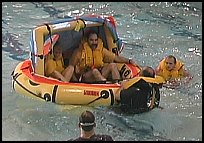 Winslow developed their unapproved GAST Super-Light Island Flyer line of rafts in sizes for 4, 6, and 8 persons for the light Part 91 General Aviation market. This raft competes with the double-cell single tube Hoover and EAM rafts. We tested four person Part 91 equipped Island Flyers. This is a conventional octagonal, single tube (12 inch), double cell design with a pair of vertical bulkheads.
Winslow developed their unapproved GAST Super-Light Island Flyer line of rafts in sizes for 4, 6, and 8 persons for the light Part 91 General Aviation market. This raft competes with the double-cell single tube Hoover and EAM rafts. We tested four person Part 91 equipped Island Flyers. This is a conventional octagonal, single tube (12 inch), double cell design with a pair of vertical bulkheads.
The "Basic" GAST we reviewed in 1996 has been eliminated from the line, but essentially the same raft can be had by optioning a RescueRaft II with ballast and Part 91 SEP. It would be the least expensive, lightest (18 lbs. for the four person), most compact Winslow life raft, sans canopy and equipped with only the bare minimum of a survival equipment pack (SEP).
 For 2000, Winslow offers the GAST Island Flyer and Island Flyer Plus. These life rafts are identical except for the inclusion of Winslow's unique viewing ports on the Plus version. These incorporate a single-hoop self-erecting canopy and all the usual Winslow features, as well as their Part 91 SEP which exceeds Part 91 requirements. Of course, that ups size and weight (approximately 31 lbs. for a four person).
For 2000, Winslow offers the GAST Island Flyer and Island Flyer Plus. These life rafts are identical except for the inclusion of Winslow's unique viewing ports on the Plus version. These incorporate a single-hoop self-erecting canopy and all the usual Winslow features, as well as their Part 91 SEP which exceeds Part 91 requirements. Of course, that ups size and weight (approximately 31 lbs. for a four person).
Winslow has indicated in its brochures that TSO approval of the GAST is pending for about two years now, but apparently it isn't a priority, because this version, the FAST, has not yet be approved. Winslow VP Gerard Pickardt said that they really haven't had much interest in the proposed approved FAST, so it's been placed on the back burner.
Winslow has made a few improvements to the unapproved model FADR Super-Light DualSafe (at one time referred to as the "basic" model of the FAAV). This is, essentially, their decagonal, double tube approved FAAV Ultima life raft less the canopy, inflatable floor, storage bags and numerous "nice-to-have," but not essential, features. It is equipped with the same minimal survival equipment as on the GA-ST. It is available in 4 - 13 person sizes.
Winslow tells us many pilots have started with the standard DualSafe and then customized it to suit their particular requirements. One nice feature of the FADR is that the owner can return the raft to Winslow after purchase and add most available options at a later date, upgrading the raft as their situation or risk evaluation changes.
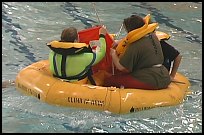 Easter Aero Marine produces a line of "T" series approved rafts for general aviation.
All are single tube, double cell designs with a pair of vertical
bulkheads. They are available as a basic raft, with no survival
gear, as well as Part 91 or Part 135 equipped. A manually
erected
canopy is optional and is included when a TSO'd raft is
specified.
These rafts come in 2, 4, 6, 8, 10 and 12 person sizes. We have tested both the T-4 and T-6 four and six person rafts. In 2000 we tested the T-4 again since it serves as a benchmark for the testers.
Easter Aero Marine produces a line of "T" series approved rafts for general aviation.
All are single tube, double cell designs with a pair of vertical
bulkheads. They are available as a basic raft, with no survival
gear, as well as Part 91 or Part 135 equipped. A manually
erected
canopy is optional and is included when a TSO'd raft is
specified.
These rafts come in 2, 4, 6, 8, 10 and 12 person sizes. We have tested both the T-4 and T-6 four and six person rafts. In 2000 we tested the T-4 again since it serves as a benchmark for the testers.
At NBAA 2000 in October 2000 EAM showed off a new "Alpha Series" of both single and double tube rafts with advanced features such as ballast, boarding aids, inflatable floors and self-erecting canopies. We have not tested these rafts.
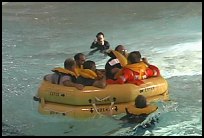 Hoover also offers a similar line of rafts with similar design
features. Not surprising since they owe their origin to the same
engineer. Since the Hoover designs are a second generation, so
to
speak, they have some minor advantages over the original EAM
designs.
Hoover also offers a similar line of rafts with similar design
features. Not surprising since they owe their origin to the same
engineer. Since the Hoover designs are a second generation, so
to
speak, they have some minor advantages over the original EAM
designs.
In 1999 Hoover introduced their first small double-tube design, the FR-6, modeled on their larger transport category deigns. This six-person octagonal raft is reversible with the floor between the two tubes. In other words, there is no top or bottom. This means there is no possibility of the raft inflating upside down and needing to be righted. Obviously, that could be a significant advantage, all other things being equal. Unfortunately, they are not equal. It uses the same manually erectable canopy design as their single tube rafts.
 Winslow sent us a prototype of a model FA-DSR "StaDri" in 1996 This was a
unique, octagonal, single tube, double cell, inflatable floor
design with one very exceptional feature. The patent pending
design utilizes a proprietary horizontal bulkhead that we found offered many advantages. The raft was equipped with a self-erecting stay-erect canopy. The StaDri was to be
available in 4, 6 and 8 person size. Winslow's plan was to obtain TSO approval, but only a few of these rafts were ever produced before the line was terminated. Explains Winslow's Shoaff, "it was just too costly to produce and the market apparently wasn't there for an even more expensive single tube design, even if it did offer significant performance advantages over a conventional design." We were impressed with this design and have left some references to it in this review, where appropriate.
Winslow sent us a prototype of a model FA-DSR "StaDri" in 1996 This was a
unique, octagonal, single tube, double cell, inflatable floor
design with one very exceptional feature. The patent pending
design utilizes a proprietary horizontal bulkhead that we found offered many advantages. The raft was equipped with a self-erecting stay-erect canopy. The StaDri was to be
available in 4, 6 and 8 person size. Winslow's plan was to obtain TSO approval, but only a few of these rafts were ever produced before the line was terminated. Explains Winslow's Shoaff, "it was just too costly to produce and the market apparently wasn't there for an even more expensive single tube design, even if it did offer significant performance advantages over a conventional design." We were impressed with this design and have left some references to it in this review, where appropriate.
 Over the past three raft reviews we have tested 4, 10, and 12-person versions of Winslow's FAAV life raft, now called the "Super-Light Ultima." It's their top-of-the-line TSO'd raft. This is a decagonal, double tube, inflatable floor raft with a self-erecting, stay-erect canopy.
It comes in 4 - 13 person sizes.
Over the past three raft reviews we have tested 4, 10, and 12-person versions of Winslow's FAAV life raft, now called the "Super-Light Ultima." It's their top-of-the-line TSO'd raft. This is a decagonal, double tube, inflatable floor raft with a self-erecting, stay-erect canopy.
It comes in 4 - 13 person sizes.
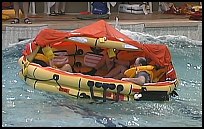 For 2000 Winslow also sent us a four- and a 12-person "FAUL Ultra-Light." These are evolutions, or perhaps we should say "devolutions," of the Ultima. With the big iron manufacturers insisting on lighter weight rafts, Winslow "made compromises to save weight where they would least affect survivability while retaining the features of the Ultima the pilots and crew told us were most important to them," claimed Winslow's Gerard Pickhardt.
For 2000 Winslow also sent us a four- and a 12-person "FAUL Ultra-Light." These are evolutions, or perhaps we should say "devolutions," of the Ultima. With the big iron manufacturers insisting on lighter weight rafts, Winslow "made compromises to save weight where they would least affect survivability while retaining the features of the Ultima the pilots and crew told us were most important to them," claimed Winslow's Gerard Pickhardt.
Canopy material was changed from the heavier dual-color material to the industry standard semi-transparent orange ripstop nylon. The buoyancy tubes were made smaller, reducing freeboard and reserve freeboard significantly, a notable reduction in overall capability. That had the salutary side effect of increasing interior space. Lifelines were changed to one-inch webbing from the standard two-inch, but two-inch is retained for all the boarding and righting aids. Storage bag material was changed to a lighter weight. A smaller cylinder is needed with less volume to fill. In all other respects the rafts remain the same.
A variety of FAA and JAR survival equipment packs are available for both the FAAV and FAUL. A non-approved 2-person FAAV is also available. These rafts are also available in an optional hard pack designed to fit specific aircraft.
 RFD/Revere supplied a
seven person "R"
series TSO'd raft. This is an
octagonal, double tube raft with an auto-inflating, manually
erectable, stay-erect canopy. It is constructed of bright yellow
PCF. The "R" series is available in 5 through 10 and 12 through
18
person capacity.
RFD/Revere supplied a
seven person "R"
series TSO'd raft. This is an
octagonal, double tube raft with an auto-inflating, manually
erectable, stay-erect canopy. It is constructed of bright yellow
PCF. The "R" series is available in 5 through 10 and 12 through
18
person capacity.
This reversible raft has some unique features that set it apart from all of the other rafts. This raft was originally developed specifically for helicopters used in the North Sea oil fields and RFD calls it a "Heliraft" in the factory brochures and information supplied to us. In order to meet the unique requirements of this industry, it was deemed necessary to compromise and change some of the requirements in the CAA (U.K. counterpart to the FAA) Specifications (counterpart to our TSO) for life rafts, which, by the way, are generally superior to the FAA's TSO C70a, with but a few minor exceptions. (See CAA Specification No.2 "Inflatable Liferafts")
The Specification was amended to accommodate these changes in an Appendix titled "Helicopter Liferafts." Included is the following rational for the compromises and changes: "a basic consideration is that helicopter over water operations are relatively short range . . .The time survivors are likely to spend in liferafts after a helicopter ditching is therefore envisaged to be limited." That might not be the case with fixed wing aircraft. In addition, these North Sea rafts are often equipped with advanced electronic beacons and radar transponders which further contribute to a quicker response time by Search and Rescue (SAR).
It is also worth noting that both pilots and passengers in North Sea and most other similar offshore operations receive considerable water survival training including dunker training and training in the use of the life raft. Training can overcome some otherwise significant flaws in any life raft. Pilots and passengers are also required to wear survival exposure/floatation suits in colder waters, giving them far greater protection than is typically found in other General Aviation sectors.
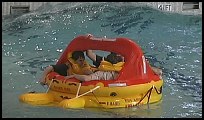 | |
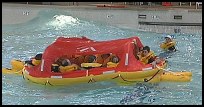 |
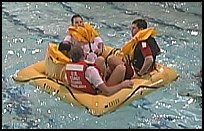 | |
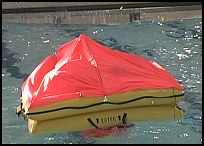 |
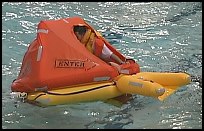 | |
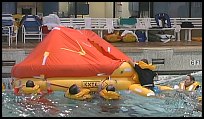 |
At NBAA 2000 in October 2000, Air Cruisers showed off a new 10-person raft without some of the features of the rafts above to reduce weight, pack volume and cost. We have not tested this raft.
| Aviation Life Raft Review (click to continue to next page) |
|
| SELECT AND USE OUTDOORS AND SURVIVAL EQUIPMENT, SUPPLIES AND TECHNIQUES AT YOUR OWN RISK. Please review the full WARNING & DISCLAIMER about information on this site. |
Publisher and Editor: Doug Ritter
|
© 1994, 1995, 1996, 2000 Douglas S. Ritter - All rights
reserved. Check our Copyright Information page for additional information. |